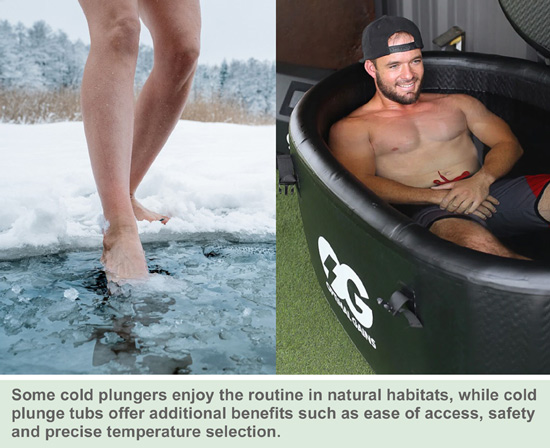You may have seen a locker room video of professional athletes submerging into an ice bath after a big game. This routine is referred to as a “cold plunge.” It’s also known as cold therapy, cold water immersion, and, when used historically for a specific medical condition, cryotherapy.
Whatever name is used, modern research is showing the long-practiced tradition of cold water exposure provides health benefits that extend far beyond exercise recovery.
The ins and outs of cold water immersion are as varied as the different names. There are different recommendations on temperatures and immersion times.
In past decades a “plunge” indicated a quick immersion. A “bath” meant a longer immersion—as the name implies. However, more recently the practice has trended towards longer immersion times, and when a person uses the term “plunge” today they may still be referring to a longer, therapeutic immersion.
Part of this trend is due to pop culture and social media challenges; however, the trend is also due to emerging research showing that longer ice-cold baths of two minutes or longer can gain additional benefits. Some advocates even push the limits to ten minutes or more.
A search on the Internet will show advocates of cold water immersion accomplishing the task in a number of different ways. Some do it in the great outdoors—if the natural habitat provides ice water in which to do it. Some improvise with bags of ice in their regular home bathtub. Many others use expertly-designed tubs manufactered for safety, ease-of-use, and temperature accuracy.
Brief history
According to Wikipedia, “cryotherapy” can be tracked as far back as 3000 BC when the ancient Egyptians used the process for wound treatment.
Records show the ancient Greeks also employed cold water immersion—primarily as a treatment for fevers—some two thousand years ago.
On the other side of the globe, the ancient Mayan and Yucatan civilizations utilized the practice of “ice baths and ice-water baths” as a treatment of heatstroke.
In more recent times cold-water immersion was used first as a form of socialization and relaxation in Scandanavian countries—before its physiological and psychological benefits were noted.
Cold water immersion was not utilized for post-exercise recovery until the 1960s; however, today the use of cold-water immersion for post-exercise recovery and treatment is by far the most popular and well-known use.
While the list of potential benefits of ice baths is extensive, here we’ll provide a primer of six most-recognized and research-backed benefits:
1. Exercise recovery and rejuvenation
As mentioned above, recovery and rejuvenation after strenuous exercise is the most common use for cold water immersion routines today.
A 2012 study conducted at Charles Stuart University in Australia found cold water immersion after exercise helped reduce muscle soreness and provided faster recovery of muscle strength, power, and neuromuscular function.
2. Inflammation and swelling reduction
Exercise often results in swelling and edema (fluid build-up causing swelling). Cold water immersion appears to provide anti-inflammatory effects due to the vasoconstriction and vasodilation of blood vessels.
An early U.S. immersion study on rats, conducted in 1997, demonstrated that cold water immersion of limbs immediately after blunt injury was effective in curbing edema formation.
More recently, a 2018 Brazilian study found cold water immersion reduced oxidative stress parameters, reduced inflammatory markers, and delayed the onset of muscle soreness.
3. Mood enhancement
Many advocates say cold water immersion boosts their mood. According to researchers, this happens because the ice water encourages endorphin release and dopamine spikes.
A study conducted in the Czech Republic, published in the European Journal of Applied Physiology, demonstrated that immersion in cold water causes a significant increase in dopamine levels.
The study—one of the most widely disseminated—found that when participants were immersed in water at a temperature of 14°C (57°F), their dopamine levels increased by up to 250%.
Meanwhile, a Finnish study published in 2009 found cold water immersion stimulated release of norepinephrine.
Norepinephrine is an organic chemical that functions in the brain and body as both a hormone and neurotransmitter. In the brain, norepinephrine increases arousal and alertness, promotes vigilance, enhances formation and retrieval of memory, and focuses attention.
4. Reduced stress and better sleep
A reduction in stress and improved sleep are inter-connected benefits that are related to mood enhancement.
Exposure to cold water triggers the release of hormones like adrenaline and norepinephrine, which have already been shown to elevate alertness and mental focus in the aforementioned Finnish study. This process can create a natural energy boost that tapers off as the day progresses, aligning with the body’s daytime wakefulness and evening sleep patterns.
Stress reduction is also related to pain reduction. A 2022 Indonesian study on patients with gout concluded: “Immersion in water at 20–30°C significantly decreased pain and increased the quality of life.”
5. Enhanced immune function
Exposing the body to cold water can stimulate the production of certain immune mechanisms, such as white blood cells. These cells play a vital role in combating infections and pathogens. Over time, regular cold water immersion appears to contribute to a stronger immune system, leading to a reduced likelihood of falling ill.
An English study, published in the Journal of Physiology, found that taking daily cold showers increased the numbers of disease-fighting white blood cells. The research suggested that, as the body tries to warm itself during and after a cold shower, metabolic rate speeds up and activates the immune system—leading to the release of more white blood cells.
A Czech Republic study seeking to determine if the immune system could be activated by non-infectious means proved that it could, in fact, be done via cold water immersion.
Finally, a notable study that was conducted in the Netherlands involved a large randomized controlled trial. Study participants topped off a hot shower with either a 30-second, 60-second or 90-second cold shower. Those who performed the cold water routine saw a 29% reduction in sickness absences from work.
Final thoughts
Other benefits of cold water immersion include hormone regulation, potential testosterone increase, metabolism boost, and toxin removal via lymphatic drainage.
While some experts caution that many of the health claims related to cold plunging are observational and vary from person to person, research is ongoing and new evidence is emerging regularly. Keep watching Optimal Health Insider for future updates.
– – –
Sources: All sources provided via links within article.




